| |
|
47.
 | Coma Manifesto 02
| Coma Manifesto 02 |
| |

'' mounir fatmi, puts language on the scene as one of the fundamental elements of his investigations through Coma Manifesto,
a kind of essential redoubt of his ideas that safeguards his intellect, artistic integrity,
and what relates to his personal life. ''
Fernando Gómez de la Cuesta, March 2021
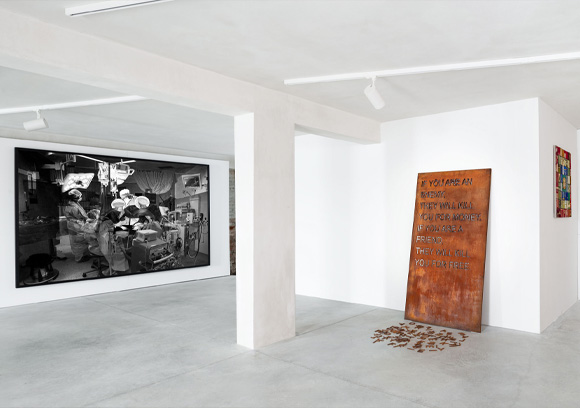
Coma Manifesto
Exhibition view from Embodied Echoes: Stories of the Foreign Soul, Piero Atchugarry Gallery, 2024, Venice.
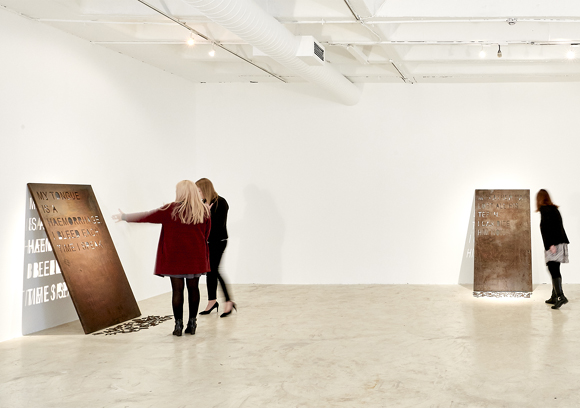
Coma Manifesto
Exhibition view from Fragmented Memory, Goodman Gallery, 2017, Johannesburg.

Coma Manifesto
Exhibition view from Fragmented Memory, Goodman Gallery, 2017, Johannesburg.
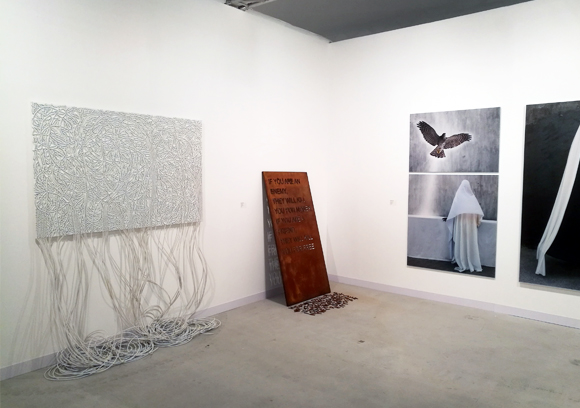
Coma Manifesto
Exhibition view from Abu Dhabi Art, Officine dell'Immagine, 2019, Abu Dhabi.
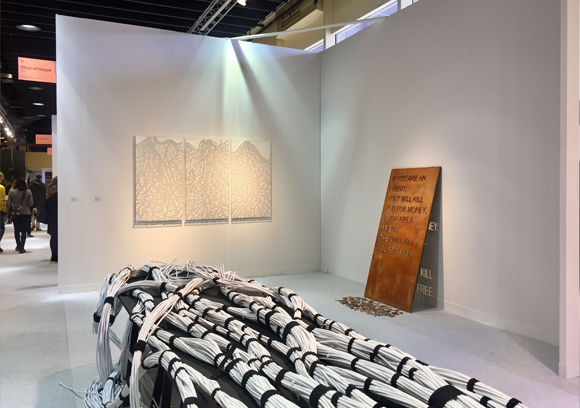
Coma Manifesto
Exhibition view from Armory Show, Officine dell'Immagine, 2019, New York.
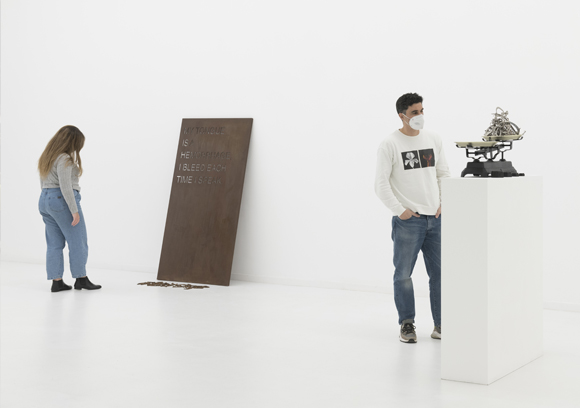
Coma Manifesto
Exhibition view from The Observer Effect, ADN Galeria, 2021, Barcelona.
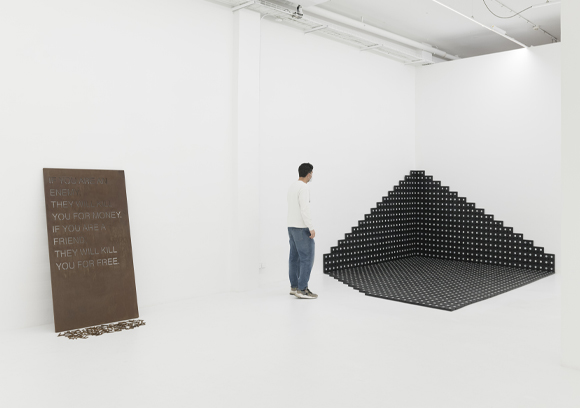
Coma Manifesto
Exhibition view from The Observer Effect, ADN Galeria, 2021, Barcelona.
|
|
2017, Steel Variable, 170cm x 90cm x 5mm
Exhibition view from Fragmented Memory, Goodman Gallery, 2017, Johannesburg.
Courtesy of the artist and Ceysson & Bénétière.
Ed. of 5 + 1 A.P.
|
|
|
| This work was part of 13ème Biennale de Dakar - L'heure Rouge, Dakar, 2018.
« Coma, Manifesto » est une sculpture réalisée à l'aide de plaques métalliques corrodées, présentant des traces irrégulières d'oxydation naturelle plus ou moins avancée, et dans lesquelles ont été découpées au laser des inscriptions en anglais, aussi concises que précises, extraites du « Manifeste » de mounir fatmi : I did not have spring, I did not have summer, and here is winter already, My father has lost all his teeth, I can bite him now, ou encore My tongue is a hemorrhage, I bleed each time I speak. Une des extrémités des plaques s'appuie contre le mur, tandis que l'autre repose au sol, selon divers angles d'inclinaison, entraînant des jeux d'ombre et de lumière et la projection du texte sur les murs de l'espace d'exposition. Aux pieds de ces tablettes massives d'inscriptions, sont disposées en tas les chutes métalliques produites par la découpe des lettres dans le métal.
Le titre de l'œuvre semble relever de l'oxymore : il associe d'un côté un surgissement, un élan vital, l'expression d'un désir, l'affirmation enfin d'une volonté claire et consciente, et de l'autre un état de cessation d'activité, de léthargie, proche du rêve et de ses manifestations inconscientes. Avec la sculpture « Coma, Manifesto », mounir fatmi met en scène le langage et la langue, en les envisageant sous l'angle de leur quasi corporéité, et il se demande comment assurer la sauvegarde de sa propre intégrité physique, intellectuelle et artistique, tout comme celle de l'élan vital et créateur. Comment en effet éviter la mise à mort de la reconnaissance artistique ? Et que reste-t-il finalement de l'artiste dans son œuvre une fois celle-ci réalisée?
Avec « Coma », œuvre sculpturale antérieure, il était question du geste qui sauve. De la même manière « Coma, Manifesto » propose un traitement médical et linguistique en réponse à un danger. L'établissement du manifeste artistique se conçoit comme une forme de médication. Le manifeste, dans sa version écrite et publiée, se décline ainsi en diverses parties intitulées « Précautions »", « Posologie », « Effets indésirables » etc. La sculpture vient quant à elle réaliser le programme esthétique de l'artiste en insistant sur certains points. Elle rappelle que celui-ci se fonde d'abord sur le témoignage et l'autobiographique, c'est-à-dire sur la relation par l'artiste de son histoire personnelle ou familiale à la première personne. Ce programme repose également sur le jeu des « contrastes » : entre ombre et lumière, entre le plein et le creux, l'exprimé et le non-dit, la lourdeur et la légèreté, la parole éphémère et son inscription pérenne dans la matière. Ces contrastes dramatisent la question de la préservation de l'intégrité artistique et servent à exprimer des oppositions ou des processus dialectiques à l'œuvre dans la résolution de contradictions se déroulant à la fois sur un plan plastique et existentiel.
Les correspondances artistiques constituent également un point fondamental du manifeste (ici entre écriture et arts dits « plastiques ») : l'activité artistique a pour vocation de découvrir des liens, d'établir des connexions. Elle mène l'exploration sans relâche des rapports entre langue et culture dans le but d'établir les conditions d'apparition de la pensée critique et autonome. Le programme esthétique de mounir fatmi désire enfin l'association d'une forme de sensibilité poétique relevant de l'intuition à la « rigueur formelle » illustrée ici par l'aspect géométrique de l'œuvre et le recours à la sentence et à l'aphorisme : formulations concises et précises, exigeantes et stylisées, dont le fort pouvoir expressif en fait de véritables points d'ancrage mémoriels.
Studio Fatmi, février 2017. |
|
« Coma, Manifesto » is a sculpture made with corroded metal plates showing irregular traces of natural and more or less advanced oxidization, into which precise and concise inscriptions in English were cut out with a laser, taken from mounir fatmi’s « Manifesto »: I did not have spring, I did not have summer, and here is winter already, My father has lost all his teeth, I can bite him now, as well as My tongue is a hemorrhage, I bleed each time I speak. One end of the plates rests against the wall, the other is on the ground, with varying angles of inclination, creating a play of light and shadow and projecting the text on the walls of the exhibition space. At the foot of these massive scripture tablets, scraps resulting from the cutting out of the metal are strewn in piles.
The title of the piece seems to be an oxymoron: it associates on one hand an upsurge, a vital force, the expression of a desire, the affirmation of a clear and conscious will, and on the other hand a state of suspended activity, of lethargy close to dreaming and its unconscious manifestations. With the sculpture “Coma, Manifesto”, Mounir Fatmi highlights language and examines it in its corporeality, so to speak. He wonders how to safeguard one’s physical, intellectual and artistic integrity, as well as that of the creative and vital drive. Indeed, how can the death of artistic recognition be avoided? And in the end, what is left of the artist in his or her work once it’s achieved?
« Coma », a previous sculptural work, was about the gesture that saves. In the same way, “Coma, Manifesto” offers a medical and linguistic treatment as a response to danger. Establishing the artistic manifesto can be seen as a form of medication. The manifesto, in its written and published version, is divided into several parts called “Precautions”, “Dosage”, “Adverse Effects”, etc. As for the sculpture, it is there to realize the artist’s esthetic program by insisting on certain points. It reminds us that this program is primarily based on testimony and autobiography, in other words on the account by the artist of his personal and family history, told in the first person. It is also based on a play on “contrasts”: between light and shadow, full and hollow, expressed and unspoken, heaviness and levity, the ephemeral spoken word and its permanent inscription in matter. These contrasts dramatize the issue of preserving artistic integrity and help express the oppositions and dialectical processes that are at play in the resolution of contradictions existing on both a plastic and existential level.
Artistic correspondences also constitute a fundamental aspect of the manifesto (in this case, between writing and so-called “plastic” arts): the vocation of artistic activity is to discover relations, establish connections. It tirelessly explores the relations between language and culture in order to create the required conditions that enable the emergence of critical and autonomous thinking. Finally, Mounir Fatmi’s esthetic program aims to associate a form of poetic sensitivity that has to do with intuition with “formal precision”, as illustrated here with the geometrical aspect of the piece and the use of maxims and aphorisms: concise and precise statements, strictly stylized, that become memorial anchors, thanks to their strong power of expression.
Studio Fatmi, February 2017. |
|
|
|